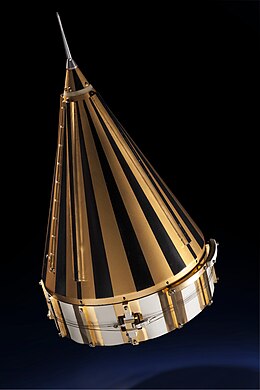 Pioneer 4 flight spare | |
| Mission type | Lunar flyby |
|---|---|
| Operator | NASA |
| Harvard designation | 1959 Nu 1 |
| COSPAR ID | 1959-013A |
| SATCAT no. | 113 |
| Mission duration | 3 days, 10 hours and 29 minutes |
| Spacecraft properties | |
| Manufacturer | Jet Propulsion Laboratory |
| Launch mass | 6.08 kg[1] |
| Start of mission | |
| Launch date | 3 March 1959, 05:10:56 GMT |
| Rocket | Juno II |
| Launch site | Cape Canaveral, LC-5 |
| Contractor | Chrysler |
| End of mission | |
| Last contact | 6 March 1959, 15:40:00 GMT |
| Orbital parameters | |
| Reference system | Heliocentric |
| Semi-major axis | 1.1015 AU |
| Eccentricity | 0.07109 |
| Perihelion altitude | 0.98 AU |
| Aphelion altitude | 1.13 AU |
| Inclination | 1.5° |
| Period | 398.0 days |
| Epoch | 3 March 1959 [2] |
| Flyby of Moon | |
| Closest approach | 4 March 1959, 22:25 GMT |
| Distance | 58,983 kilometres (36,650 mi) |
Pioneer 4 was an American spin-stabilized uncrewed spacecraft launched as part of the Pioneer program on a lunar flyby trajectory and into a heliocentric orbit making it the first probe of the United States to escape from the Earth's gravity. Launched on March 3, 1959, it carried a payload similar to Pioneer 3: a lunar radiation environment experiment using a Geiger–Müller tube detector and a lunar photography experiment. It passed within 58,983 km (36,650 mi) of the Moon's surface. However, Pioneer 4 did not come close enough to trigger its photoelectric sensor. The spacecraft was still in solar orbit as of 1969.[2] It was the only successful lunar probe launched by the U.S. in 12 attempts between 1958 and 1963; only in 1964 would Ranger 7 surpass its success by accomplishing all of its mission objectives.
After the Soviet Luna 1 probe conducted the first successful flyby of the Moon on 3 January 1959, the pressure felt by the US to succeed with a lunar mission was enormous, especially since American mission failures were entirely public while the Soviet failures were kept a secret.